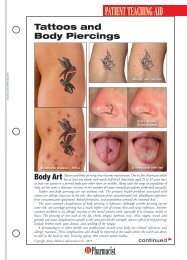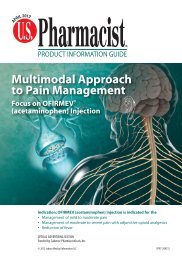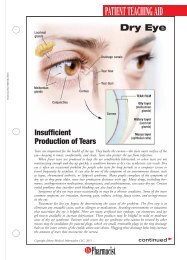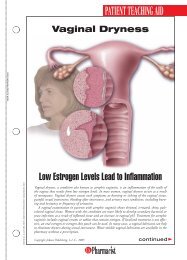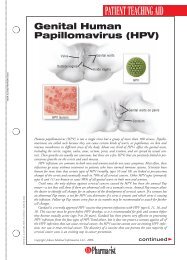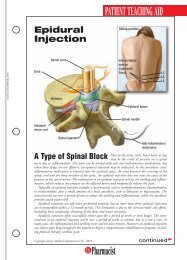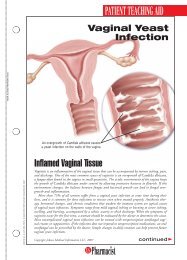View PDF Edition - U.S. Pharmacist
View PDF Edition - U.S. Pharmacist
View PDF Edition - U.S. Pharmacist
You also want an ePaper? Increase the reach of your titles
YUMPU automatically turns print PDFs into web optimized ePapers that Google loves.
TRAUMATIC BRAIN INJURYHEALTH SYSTEMS EDITIONconcerning what the appropriate prophylactic measuresshould contain for patients with TBI. Most studies citedby the 2007 guidelines evaluating prophylactic antibioticusage in patients with external ventricular drainagehave shown no difference in infection rates. Additionally,one study showed that patients receiving bacitracinflushes experienced a significantly higher infectionrate than those without prophylactic measures. 7Prophylactic antibiotic use in patients with TBI haveshown no meaningful reduction in nosocomial infections.7 In addition, an increase in serious gram-negativeinfections was noted in this population. The guidelinesalso cite data showing an increase in resistant orgram-negative nosocomial pneumonias. This was seenwhen prophylactic antibiotics were given for longer than48 hours in general trauma patients. In contrast, onestudy showed a decrease in pneumonias when prophylacticantibiotics were given to patients with TBI. Nodifference in mortality was noted, so it is difficult toassess the usefulness of this therapeutic avenue. 7Since publication of the 2007 guidelines, one furtherstudy in patients with TBI has been completed. 8This study retrospectively evaluated the use of antibioticprophylaxis in patients with ICP monitor implantation.Of the 155 patients included in the analysis,only two developed CNS infections, and these wereboth in the group that received prophylactic antibiotics.Additionally, both complications from infectionsand multidrug resistant infections were significantlyincreased in the group that received antibiotics.In summary, there are currently no convincingdata to support infection prophylaxis in patients withTBI, especially in light of data suggesting that prophylaxismight predispose patients to more severe infectionswhen infections would arise. 7,8 To be fair, thereis a relative lack of data to give any definitive statementon the use of prophylactic antibiotics, but at thistime this practice cannot be supported.Venous Thromboembolism ProphylaxisVenous thromboembolism (VTE) is a topic that is verypertinent to patients with TBI, as they are at an increasedrisk of developing blood clots due to their typicallypersistent immobile state. The development of deepvein thrombosis (DVT) in patients with TBI who donot receive prophylaxis is as high as 25%. 9 However,there remains some uncertainty about the appropriatenessof VTE prophylaxis due to the questionable safetyof anticoagulation in patients who have TBI. Mechanicalmeans of VTE prophylaxis such as sequential compressiondevices seem to carry less risk in patients withTBI, but concomitant lower limb injuries can preventtheir use in some patients. Per the 2007 guidelines,mechanical VTE prophylaxis is recommended in allsevere patients with TBI who have no contraindicationsto usage, such as an intracranial bleed. 10Concerning pharmacologic options, the guidelinessuggest that low-molecular-weight heparin (LMWH)or low-dose unfractionated heparin (UFH) should beused in addition to mechanical means of VTE prophylaxiswhen no contraindications to LMWH or UFHexist. It is important to note, however, that the guidelinesdo not elicit a preferred agent, dosage, or timingof pharmacologic prophylaxis and also warn of theincreased risk of intracranial hemorrhage expansion. 10Three studies have been published since the guidelineson pharmacologic VTE prophylaxis in patientswith TBI. 11-13 A 2007 prospective study evaluated theuse of dalteparin in trauma patients in which 23%were patients with TBI. 11 These patients received prophylacticdalteparin (5,000 units SQ once daily) ifthere was no active or progressing bleed on CT scan.No patients developed or had increased intracranialbleeding after initiation of dalteparin, while only 3.9%of patients had evidence of DVT and 0.8% had evidenceof pulmonary embolism. A second prospectivestudy published in 2008 evaluated the use ofenoxaparin (30 mg SQ twice daily) in patients withTBI. 12 Progressive hemorrhagic injury was seen in3.4% of the TBI population, with 67% of those patientshaving clinically insignificant hemorrhagic changes.In addition, one patient died from a potential sideeffect from enoxaparin usage. The authors of thesetwo studies concluded that enoxaparin and dalteparinare safe options in patients with TBI and that bothagents have a relatively low risk of significant bleedingcomplications. 11,12A retrospective study published in 2009 looked ata comparison of the risk of DVT in patients withand without TBI utilizing either LMWH or UFH(doses not specified). 13 This study showed a three- tofourfold increase in DVTs in patients with TBI usingrelative risks with 95% confidence intervals. The highestrate was noted when prophylaxis was started greaterthan 48 hours after insult.In summary, it is currently acceptable to recommendmechanical and pharmacologic VTE prophylaxisin patients with TBI that have no contraindicationsto usage. 10-13 The evidence is shifting in favorof quick initiation of prophylactic agents regardless ofproduct selection. However, the breakpoint for decidingbetween mechanical and pharmacologic choicesor agents is still unknown and should be a course offuture study.Seizure ProphylaxisPosttraumatic seizure (PTS) is a common occurrencein patients with TBI. These seizures are broken intotwo groups: early (within 7 days of injury) and late(after 7 days). Certain risk factors have been shownto place patients with TBI at increased risk for PTS.These risk factors include: Glasgow Coma Score (aHS-16U.S. <strong>Pharmacist</strong> • November 2009 • www.uspharmacist.com




